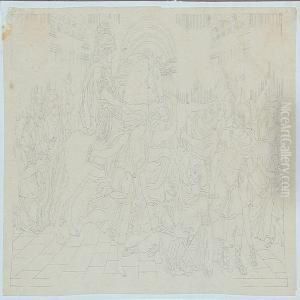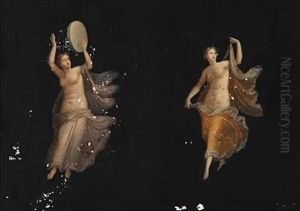Georg Christian Hilker Paintings
Georg Christian Hilker was a Danish decorative painter who played a significant role in the Danish Golden Age of painting, a period that is generally considered to be from the beginning of the 19th century until the mid-19th century. He was born on December 2, 1807, in Copenhagen, Denmark, and was recognized for his contributions to interior decoration and fresco painting, which were highly regarded during his lifetime.
Hilker received his artistic education at the Royal Danish Academy of Fine Arts in Copenhagen, where he studied under leading figures of Danish art like Christoffer Wilhelm Eckersberg. Eckersberg was a central figure in the Danish Golden Age and influenced Hilker and many other contemporary Danish artists. After completing his studies, Hilker worked on a variety of projects, including the decoration of churches and other public and private buildings. His work often featured neoclassical motifs and was characterized by its elegance and attention to detail.
Throughout his career, Hilker was known for his mastery of the fresco technique, which involves painting on wet plaster so that the pigments become an integral part of the wall surface as they dry. One of his most notable projects was the decoration of the Thorvaldsens Museum, dedicated to the sculptor Bertel Thorvaldsen, which is considered one of his major works. He also worked on the decoration of Christiansborg Palace and the University of Copenhagen's ceremonial hall, among other significant commissions.
Hilker's contributions to Danish art were not limited to his frescoes and decorative paintings. He also served as a professor at the Royal Danish Academy of Fine Arts, where he taught from 1859 until his death on February 10, 1875. In this role, he influenced a new generation of artists, passing on his knowledge and skills in decorative painting. His legacy is preserved in the many interiors he decorated, which continue to be admired for their beauty and craftsmanship.

